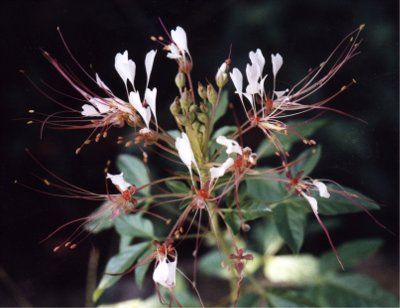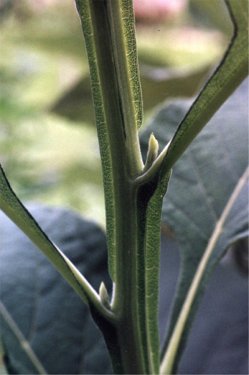
|
Weeds are just flowers that are easy to grow, and these three plants certainly fall into that category. All are natives and very common.
Clammyweed (Polanisia dodecandra) is an annual that grows easily from seed and reaches a height of about two feet. The flowers are very intricate with white petals and red stamens and occur in one large group at the top of an elongating terminal raceme. The plant gets its name from the very sticky stems and leaves, which leave a residue when the plant is touched. Small, round seeds are produced very rapidly after blooming, and the seeds ripen well before the pods turn brown, although harvesting the seeds from the green, sticky pods is a messy affair.
|
|

 A completely different sort of plant, frostweed (Verbesina virginica) does not have visually attractive flowers. They are, instead, small and white, with only a few petals, but are very alluring to insects. This perennial reaches a height of about six feet and has pretty green foliage, even during the hottest parts of the summer. The leaf stalks extend down the stems, forming thin wings. With the first freeze, the exposed parts of the plant die, the tall stalks split, and the liquid within the stems oozes out in curled, gypsum-like ice crystals, giving the weed its name. It is easy to start from seed, and after a couple of years, the plants are very large and dense. Other names for this plant are tickweed, ice plant, squaw-weed, and Indian tobacco. A completely different sort of plant, frostweed (Verbesina virginica) does not have visually attractive flowers. They are, instead, small and white, with only a few petals, but are very alluring to insects. This perennial reaches a height of about six feet and has pretty green foliage, even during the hottest parts of the summer. The leaf stalks extend down the stems, forming thin wings. With the first freeze, the exposed parts of the plant die, the tall stalks split, and the liquid within the stems oozes out in curled, gypsum-like ice crystals, giving the weed its name. It is easy to start from seed, and after a couple of years, the plants are very large and dense. Other names for this plant are tickweed, ice plant, squaw-weed, and Indian tobacco.

Before knowing anything about it, I had collected a small root segment of western ironweed (Vernonia baldwinii) that was growing along a gravel road. It had beautiful purple flowers and I hadn't seen it anywhere else and so thought it was uncommon. It's not. Ironweed, a member of the sunflower family (Asteraceae), is very easy to grow and propagate, and after one year I had a clump of several five-foot tall stems coming up from the large, tuberous roots. About the same time, I noticed ironweed growing in a drainage ditch near our yard, and now it pops up in all the gardens, probably spread by birds eating the seeds. It starts growing rather late in the spring, but soon is covered with blossoms and will continue to bloom as long as there is adequate water, until the first frost kills it back. If it gets too dry, the stems die and the plant goes dormant. The flowers are quite an attraction for all kinds of insects, but the weight of the blossoms usually makes the plants fall over so they are better having a support of some type. Western ironweed is common in cattle pastures because it has a bitter taste and the animals avoid it. The roots of ironweed have medicinal qualities and have been used to reduce fevers and as a snakebite treatment, as well as supposedly being an aphrodisiac.
|


 A completely different sort of plant, frostweed (Verbesina virginica) does not have visually attractive flowers. They are, instead, small and white, with only a few petals, but are very alluring to insects. This perennial reaches a height of about six feet and has pretty green foliage, even during the hottest parts of the summer. The leaf stalks extend down the stems, forming thin wings. With the first freeze, the exposed parts of the plant die, the tall stalks split, and the liquid within the stems oozes out in curled, gypsum-like ice crystals, giving the weed its name. It is easy to start from seed, and after a couple of years, the plants are very large and dense. Other names for this plant are tickweed, ice plant, squaw-weed, and Indian tobacco.
A completely different sort of plant, frostweed (Verbesina virginica) does not have visually attractive flowers. They are, instead, small and white, with only a few petals, but are very alluring to insects. This perennial reaches a height of about six feet and has pretty green foliage, even during the hottest parts of the summer. The leaf stalks extend down the stems, forming thin wings. With the first freeze, the exposed parts of the plant die, the tall stalks split, and the liquid within the stems oozes out in curled, gypsum-like ice crystals, giving the weed its name. It is easy to start from seed, and after a couple of years, the plants are very large and dense. Other names for this plant are tickweed, ice plant, squaw-weed, and Indian tobacco.
